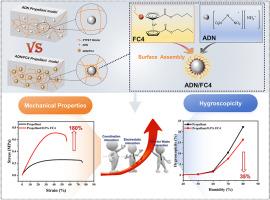Metal coordination interfacial enhancement effect: A strategy to fabricate low hygroscopic composite based on ammonium dinitramide (ADN) and polyether with enhanced mechanical properties
IF 7.7
2区 材料科学
Q1 MATERIALS SCIENCE, COMPOSITES
引用次数: 0
Abstract
Constructing and enhancing intermolecular interactions is a highly promising and versatile method for improving mechanical properties of composite materials. The application of the new green high-energy oxidizer ammonium dinitramide (ADN, NH4+N(NO2)2-) in composite solid propellants is often limited due to its low interfacial interaction with binders. In this study, a ferrocene derivative with ester side chains, dibutyl 1,1-Ferrocenedicarboxylic acid (FC4), was assembled on the ADN crystal surface to promote its interfacial properties. On one hand, the lone pair electron structure of dinitramide is utilized as ligand to central Fe2+ metal ion in ferrocene structure. On the other hand, the side chains of the ferrocene derivative enhance its van der Waals interactions with the binder. Thus, FC4 molecules act as a “bridge” to strengthen the interfacial adhesion between ADN and binder. Chemical structural characterizations and theoretical calculations confirm the existence of coordination interactions between FC4 and ADN, and the increased adsorption energy between ADN and binder. According to the experimental test results, this coordination and van der Waals force synergistic bridging effect endows the composite solid propellant with significantly enhanced tensile strength (up to 280 %), modulus (up to 305.8 %), lower hygroscopicity and sensitivity, mechanical properties of the propellant are sufficient to meet the related requirements in aerospace after the addition of FC4. This strategy provides new insights for enhancing the interfacial performance between solid fillers and binders in composite materials.

金属配位界面增强效应:制备力学性能增强的低吸湿复合材料的一种策略
构建和增强分子间相互作用是提高复合材料力学性能的一种非常有前途的通用方法。新型绿色高能氧化剂二硝酰胺铵(ADN, NH4+N(NO2)2-)在复合固体推进剂中的应用往往因其与粘结剂的界面相互作用低而受到限制。本研究将具有酯侧链的二茂铁衍生物二丁基1,1-二茂铁二羧酸(FC4)组装在ADN晶体表面,以提高其界面性能。二硝酰胺的孤对电子结构在二茂铁结构中被用作中心Fe2+金属离子的配体。另一方面,二茂铁衍生物的侧链增强了其与粘合剂的范德华相互作用。因此,FC4分子作为“桥梁”,加强ADN与粘合剂之间的界面粘附。化学结构表征和理论计算证实了FC4与ADN之间存在配位相互作用,ADN与粘合剂之间的吸附能增加。实验测试结果表明,这种配位与范德华力的协同桥接效应使复合固体推进剂的抗拉强度(可达280%)、模量(可达305.8%)显著提高,吸湿性和敏感性降低,推进剂的力学性能足以满足航空航天领域的相关要求。该策略为提高复合材料中固体填料和粘结剂之间的界面性能提供了新的见解。
本文章由计算机程序翻译,如有差异,请以英文原文为准。
求助全文
约1分钟内获得全文
求助全文
来源期刊

Composites Communications
Materials Science-Ceramics and Composites
CiteScore
12.10
自引率
10.00%
发文量
340
审稿时长
36 days
期刊介绍:
Composites Communications (Compos. Commun.) is a peer-reviewed journal publishing short communications and letters on the latest advances in composites science and technology. With a rapid review and publication process, its goal is to disseminate new knowledge promptly within the composites community. The journal welcomes manuscripts presenting creative concepts and new findings in design, state-of-the-art approaches in processing, synthesis, characterization, and mechanics modeling. In addition to traditional fiber-/particulate-reinforced engineering composites, it encourages submissions on composites with exceptional physical, mechanical, and fracture properties, as well as those with unique functions and significant application potential. This includes biomimetic and bio-inspired composites for biomedical applications, functional nano-composites for thermal management and energy applications, and composites designed for extreme service environments.
 求助内容:
求助内容: 应助结果提醒方式:
应助结果提醒方式:


